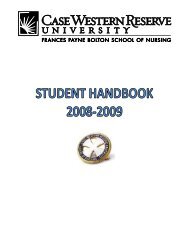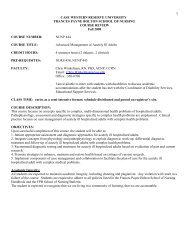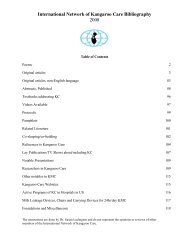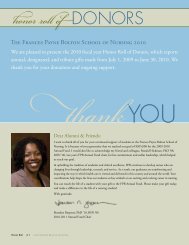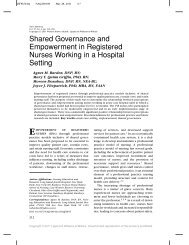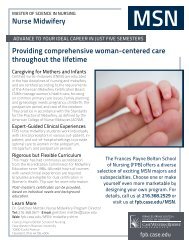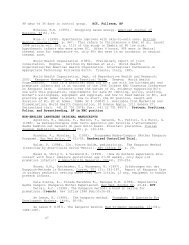Kangaroo Care BIBLIOGRAPHY Develope
Kangaroo Care BIBLIOGRAPHY Develope
Kangaroo Care BIBLIOGRAPHY Develope
Create successful ePaper yourself
Turn your PDF publications into a flip-book with our unique Google optimized e-Paper software.
Meier P, Engstrom JL, Mingoletti SS, Miracle DJ, & Kiesling S. 2004. TheRush Mothers’ Milk Club: Breastfeeding interventions for mothers with very-lowbirth-weightinfants. J.Obstet Gynecol Neonatal Nursing 33 (2), 164-174. Onpage 166: “Evidency based nonpharmacologic techniques to help preent low milkvolume, such as pumping at the infant’s bedside, skin-to-skin care, and sucklingat the emptied breast, are routinely employed by bedside nurses. PT,implementation evaluation, BF.Mellien, A.C. (2001). Incubators versus mothers’ arms: body temperatureconservation in very-low-birth-weight premature infants. JOGNN, 30(2), 157-164.Has a big review of KC literature, but this is a study of clothed mothersholding swaddled infants close. Axillary temps did not differ between incubatorand holding in VLBW infants.VLBW, SWADDLED HOLDING./Moore J, & Mcermott, J. 2004. “Body Temperature”. In Every Newborn’sHealth: Recommendations for <strong>Care</strong> for All Newborns. Washington, DC: Save theChildren. Set of guidelines for fullterm newborns. States that KC is bestfor warming and rewarming and for BF. FULL TERM, recommends KC>Mosko, S.S., Richard, C., & McKenna, J. (1997). Maternal sleep andarousal during bedsharing with infants. Sleep, 20(2): 142-150.Murdoch, D.R., & Darlow, B.A. (1984). Handling during neonatal intensivecare. Archives of Diseases in Childhood,59, 957-961.Perlman,JM. 2003. The genesis of cognitive and behavioral deficits inpremature graduates of intensive care. Minerva Pediatrics 55 (2), 89-101.Increased survival has led to deficits into school age and adolescents. Onecause of deficits is prolonged hospitalization and the stress that it causes.The stress can be minimized by positive maternal-infant interactions. Positiveinteractions enhance neurobehavioral development. KC is recommend as a positiveparent infant interaction and related to improved neurodevelopmental outcome.Review, developmentSchanler, RJ. (1995). Suitability of Human Milk for LBW Infants. Clinicsin Perinatology, 22(1): 207-222. A nursery policy that advocates early skinto-skincontact between LBW infant and mother may improve host defense of theinfants”(211). “Guidelines for feeding LBW infants must include skin-to-skincontact to promote development of maternal antibodies”(217). Premise is thatbaby’s skin picks up NICU pathogens and when in contact with mom’s skin passesthem to her. She then makes antibodies, “it is possible that the mother maymake specific IGA antibodies against nosocomial pathogens in the infant’senvironment and pass them along to the infant in her breastmilk”.Stevens BJ, Franck LS. 2001. Assessment and Management of Pain inNeonates. Pediatric Drugs 3(7), 539-558. On page.546 it refers to KC, saying ithas “improved survival, increased the incidence and duration of breastfeeding,resulted in improved respiratory and temperature control, and enhanced maternalinfantinteraction.’ However, only 1 study has investigated KC as a painmanagement strategy during acute painful stimuli…given the encouraging resultsof this study, further investigation of this technique as a potential source ofanalgesia in human neonates is most certainly warranted.”Stevens BJ, Yamada J, Ohlsson A. 2001. Sucrose for analgesia in newborninfants undergoing painful procedures. Cochrane Databae Systematic Reviews,#4,CD001069. “The use of repeated administrations of sucrose in neonates needsto be investigated as does the use of sucrose incombination with otherbehavioural (facilitated tucking, kangaroo care) and pharmacologic (morphine,fentanyl) interventions.”Weller A, Feldman R. 2003. Emotion regulation and touch in infants: the72




